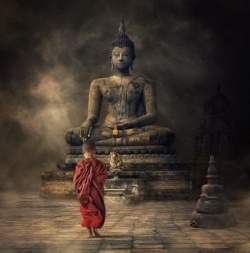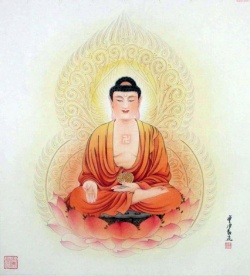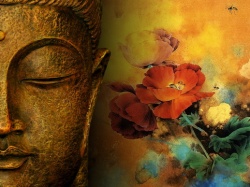Sangha in the West
Martine & Stephen Batchelor
Over time as Buddhism has developed, the idea and experience of sangha established itself in different cultures and settings. At the time of the Buddha, the sangha was the Arya Sangha --that is the assembly of the noble ones, the awakened ones-- those who followed the Buddha in the holy life and attained liberation. As the nun Sama recited:
It was twenty-five years
since I turned away from home
and I hadn't had a moment's peace.
I had no peace
Because I did not know my own mind.
I have finished with craving.
The Buddha's teaching has been done.
It is the seventh day
Since my craving died.
The Buddha's sangha was actually revolutionary because it was open to all. Its hierarchy was based on time of arrival and spiritual accomplishment, not on birth nor on caste.
The sangha became even more revolutionary when the Buddha after much debate and discussion accepted women in his sangha -- women too started to become fully ordained nuns.
The idea of sangha became even more inclusive when it was represented by the great assembly which is comprised of monks, nuns, laymen and laywomen.
As Buddhism comes to the West, what kind of sangha can we find? There is the traditional model with ordained monks and nuns,
like at Amaravati in England where the strict code of the vinaya (rules of conduct for monks and nuns) is followed in the Theravada tradition of Thailand. I
n France, you can also find large monasteries of Western monks or nuns who engage in long retreats following the Tibetan tradition like at Dhagpo Kundrel Ling in Le Bost in Auvergne or follow courses of study as in Nalanda Monastery near Lavaur.
Thich Nhat Hanh is developing at Plum Village a traditional model of sangha with monks and nuns while at the same time trying to devise a model for people who cannot become celibate and are raising children.
The advantage of a traditional model is that it is hierarchical, it has a spiritual head and a strong sense of discipline.
It might be difficult to fit in for some people but for most it gives a great support and sense of direction.
In England you can find the Friends of the Western Buddhist Order who are trying to create a different type of sangha -- in between monastics and laity.
There are various levels of commitment.
The hierarchy is still very present with their spiritual leader and founder at the top and senior teachers just below.
They are also experimenting with single sex communities.
Though recently they are finding that it is important to find a place for the family as well.
They have created right livelihood communities around which a sense of sangha is formed as people live, work and practice together.
Some Western Buddhist communities have tried to be based on a consensual model with no hierarchy and no head.
I lived in such a community in England for some time.
This is very attractive to Western people.
But it is very hard because we do not come from a culture which trains us to live together.
We are constantly urged to strive, to compete, to find our own way, to be free.
When we find ourselves having to share, to tolerate others and to understand others with only ourselves as the last authority it is very difficult.
We start with very good intentions but this does not last very long. We quickly get irritated or upset.
For this reason, I feel that living in a consensual community should be seen as practice and training moment to moment.
Sangha or community is often seen as a refuge and a support but it can only be so if the sangha members apply themselves and practice the teachings of wisdom and compassion in all their actions and encounters.
As ordinary human beings, each of us can make mistakes, so when we live in a community we need to respect each other's strengths and weaknesses.
If we persevere, they are beautiful moments where harmony emerges out of love, understanding, opening and letting go matured over time.
In America there are two interesting experiments taking place from the point of view of sangha building and sangha living.
The Buddhist Peace Fellowship developed BASE -- the Buddhist Alliance for Social Engagement -- to create a way to deepen practice and to live a life of engagement and transformation in community.
This non-residential programme provides a community-based structure for participants to spend six months doing some social work combined with Buddhist practice and training. BASE is rooted in a community of shared purpose which meets regularly to discuss, learn and practice together.
What most people commented on at the end of the first six month programme was the deepening sense of community and relationship that this had provided ñ a true sangha was created not only with themselves but also with the people they served.
As a woman who was helped said, "Thank you so much for accompanying me; it was such a luxury.
At least the Buddhists are looking out for me!"
The people involved continued to meet after the allotted times as they found it so rewarding.
As one remarked, "For me, the BASE group provided a special kind of home, where I could experiment with new ways of relating. It was hard, messy and wonderful work.
It stretched me to develop a deeper respect for difference that ultimately proved to be at the very heart of the love and support we shared."
The other project is in New Mexico. It is called Jubilados --those who are joyous.
It was started in 1997 as an effort to create a residential sangha for the elderly based on a triad of values: contemplative practice, service to community and respect for the environment.
This Trust has bought a 13-acre farm near Santa Fe that will be used to create a low-cost, rent-based community for over 120 people, two-thirds over the age of sixty.
At the moment they are fostering the creation of a non-residential community of elders who meet regularly to engage in spiritual practice, yoga and discussion about their own ageing and dying.
Sangha is the third jewel and refuge on the Buddhist path.
In the West there are many opportunities to cultivate and develop this jewel in a modern setting.
We can learn from all the different models we can find, from traditional hierarchical ones or more modern consensual ones.
Each will teach us and support us differently.
This is a very important aspect of the practice that Westerners who come to Buddhism cannot ignore. It is inspiring that people are being creative in finding new ways to create meaningful communities.


